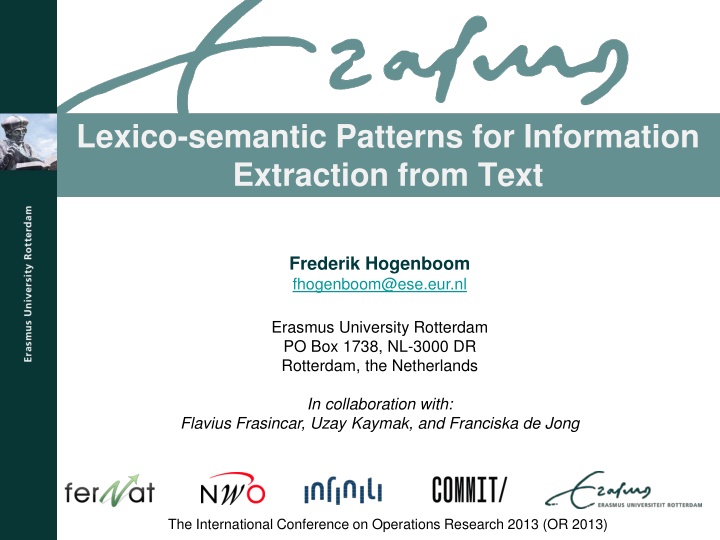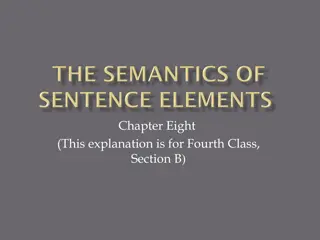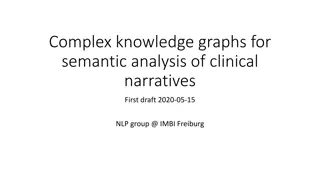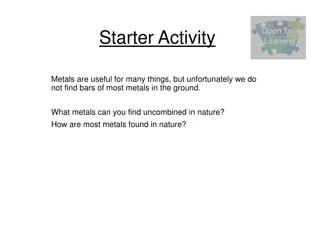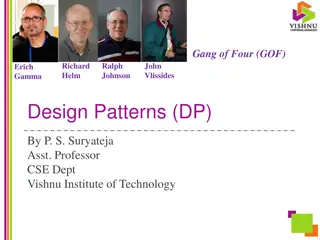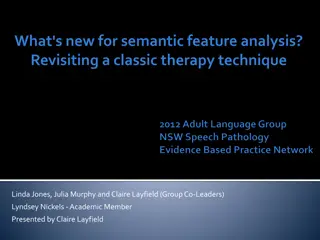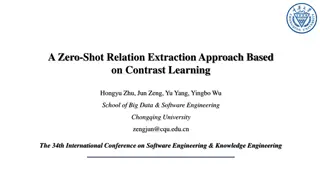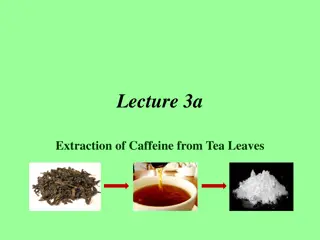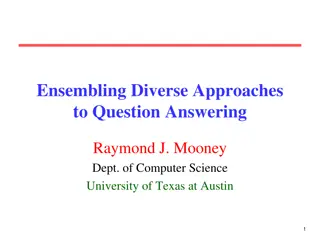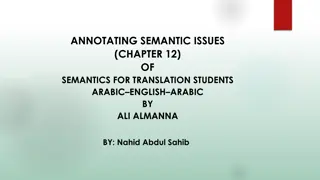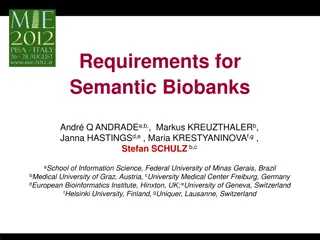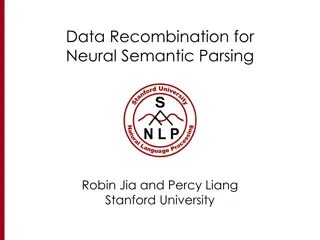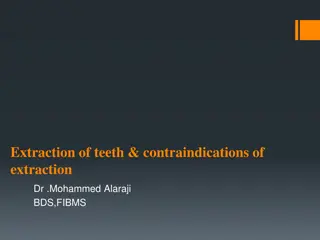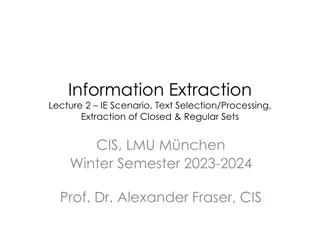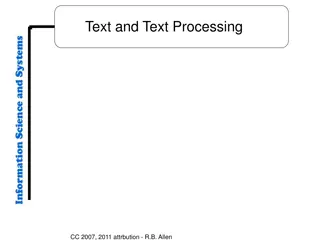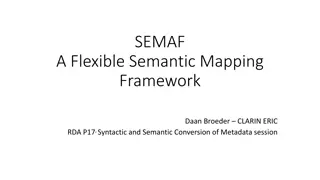Lexico-semantic Patterns for Information Extraction from Text
Increasing digital data necessitates automated processing for information extraction. Explore expert knowledge-driven event extraction using pattern languages at The International Conference on Operations Research 2013.
Download Presentation

Please find below an Image/Link to download the presentation.
The content on the website is provided AS IS for your information and personal use only. It may not be sold, licensed, or shared on other websites without obtaining consent from the author.If you encounter any issues during the download, it is possible that the publisher has removed the file from their server.
You are allowed to download the files provided on this website for personal or commercial use, subject to the condition that they are used lawfully. All files are the property of their respective owners.
The content on the website is provided AS IS for your information and personal use only. It may not be sold, licensed, or shared on other websites without obtaining consent from the author.
E N D
Presentation Transcript
Lexico-semantic Patterns for Information Extraction from Text Frederik Hogenboom fhogenboom@ese.eur.nl Erasmus University Rotterdam PO Box 1738, NL-3000 DR Rotterdam, the Netherlands In collaboration with: Flavius Frasincar, Uzay Kaymak, and Franciska de Jong The International Conference on Operations Research 2013 (OR 2013)
Introduction (1) Increasing amount of (digital) data Problem: utilizing extracted information in decision making processes becomes increasingly urgent and difficult: Too much data for manual extraction Yet most data is initially unstructured Data often contains natural language Solution: automatically process and interpret information, yet automation is a non-trivial task The International Conference on Operations Research 2013 (OR 2013)
Introduction (2) Information Extraction (IE) Multiple sources: News messages Blogs Papers Text Mining (TM): Natural Language Processing (NLP) Statistics Specific type of information that can be extracted: events The International Conference on Operations Research 2013 (OR 2013)
Events (1) The International Conference on Operations Research 2013 (OR 2013)
Events (2) Event: Complex combination of relations linked to a set of empirical observations from texts Can be defined as: <subject> <predicate> <subject> <predicate> <object> e.g., <Company> <Buys> <Company> e.g., <Person> <Resigns> Event extraction could be beneficial to IE systems: Personalized news Risk analysis Monitoring Decision making support The International Conference on Operations Research 2013 (OR 2013)
Events (3) Common event domains: Medical Finance Politics Environment The International Conference on Operations Research 2013 (OR 2013)
Event Extraction In analogy with the classic distinction within the field of modeling, we distinguish 3 main approaches: Data-driven event extraction: Statistics Machine learning Linear algebra Expert knowledge-driven event extraction: Representation & exploitation of expert knowledge Patterns Hybrid event extraction: Combine knowledge and data-driven methods Our focus: expert knowledge-driven event extraction through the usage of pattern languages The International Conference on Operations Research 2013 (OR 2013)
Existing Approaches Various pattern-languages for: News processing frameworks (e.g., PlanetOnto) General purpose frameworks (e.g., CAFETIERE, KIM, etc.) Language types: Lexico-syntactic Lexico-semantic However: Limited syntax Weak semantics Cumbersome in use Extract entities, but not events The International Conference on Operations Research 2013 (OR 2013)
Semantics Semantic Web: Collection of technologies that express content meta-data Offers means to help machines understand human-created data on the Web Ontologies: Can be used to store domain-specific knowledge in the form of concepts (classes + instances) Also contain inter-concept relations The International Conference on Operations Research 2013 (OR 2013)
Pattern Language (1) Basic syntax: LHS :- RHS LHS: subject, predicate, object (optional) RHS: pattern in which subject and object are assigned: Literals (text strings) Lexical categories (nouns, prepositions, verbs, etc.) Orthographic categories (capitalization) Labels (assigning subject and object) Logical operators (and, or, not) Repetition ( 0, 1, 0-1, {min,max}) Wildcards (skip 0 or exactly 1 word) Ontological concepts The International Conference on Operations Research 2013 (OR 2013)
Pattern Language (2) Provocation example (lexico-syntactic): ($sub, kb:provokes, $obj) :- $sub:=(((JJ | NNS | NNP | NNPS | NN) & (upperInitial | allCaps | mixedCaps) )( . NNP . ?)?)+ (! . & ! ( & ! ) & ! - ){0,3} ( angers | angered | accuses | accused | insult | insulted | provokes | provoked | threatens | threatened ) (! . & ! ( & ! ) & ! - ){0,3} $obj:=(((JJ | NNS | NNP | NNPS | NN) & (upperInitial | allCaps | mixedCaps) )( . NNP . ?)?)+ The International Conference on Operations Research 2013 (OR 2013)
Pattern Language (3) Provocation example (lexico-semantic): ($sub, kb:provokes, $obj) :- $sub:=([kb:Country] | [kb:Continent] | [kb:Union]) (! . & ! ( & ! ) & ! - ){0,3} (kb:toAnger | kb:toAccuse | kb:toInsult | kb:toProvoke | kb:toThreaten) (! . & ! ( & ! ) & ! - ){0,3} $obj:=([kb:Country] | [kb:Continent] | [kb:Union]) The International Conference on Operations Research 2013 (OR 2013)
Implementation (1) The Hermes News Portal (HNP) is a stand-alone Java-based news personalization tool We have implemented the Hermes Information Extraction Engine (HIEE) within the HNP Pipeline-architecture is based on GATE components The International Conference on Operations Research 2013 (OR 2013)
Implementation (2) The International Conference on Operations Research 2013 (OR 2013)
Evaluation (1) We compare the performance of lexico-syntactic rules with lexico-semantic rules on two data sets: Economic events (500 news messages): CEO Profit Product Loss Shares Partner Competitor Subsidiary Political events (100 news messages): Election Resignation Visit Investment Sanction Riots Join Collaboration President Revenue Provocation Help Performance is evaluated based on rule creation times and precision, recall, and F1-measure. The International Conference on Operations Research 2013 (OR 2013)
Evaluation (2) Creation times for F1 0.5: 90% improvement Name CEO Product Shares Competitor Profit Loss Partner Subsidiary President Revenue Overall Lex-Syn Lex-Sem 8424 9428 2403 9116 1923 5991 4924 6620 4239 5317 5839 Name Election Visit Sanction Join Resignation Investment Riots Collaboration Provocation Help Overall Lex-Syn Lex-Sem 1517 4238 4013 3986 1259 5162 1734 1103 1428 1987 2643 281 132 648 133 416 313 185 776 179 498 356 232 543 419 297 366 781 306 137 530 211 382 The International Conference on Operations Research 2013 (OR 2013)
Evaluation (3) Scores after maximum time (finance) Lex-Syn Lex-Sem Name CEO Product Shares Competitor Profit Loss Partner Subsidiary President Revenue Overall Precision Recall 0.5217 0.6000 0.5581 0.6667 0.4118 0.5091 0.4286 0.6667 0.5218 0.5333 0.4800 0.5052 0.7500 0.4545 0.5660 0.6471 0.4074 0.5000 0.3864 0.7391 0.5075 0.7500 0.3913 0.5143 0.4333 0.5909 0.5000 0.6429 0.4091 0.5000 0.5492 0.4935 0.5199 F1 Precision Recall 0.8966 0.8667 0.8814 0.8607 0.7721 0.8140 0.9000 0.8000 0.8471 0.7600 0.7600 0.7600 0.8800 0.6667 0.7586 0.8125 0.4815 0.6047 0.8000 0.8696 0.8333 0.9063 0.6304 0.7436 0.6667 0.6364 0.6512 0.7143 0.6818 0.6977 0.8390 0.7414 0.7872 F1 The International Conference on Operations Research 2013 (OR 2013)
Evaluation (4) Scores after maximum time (politics) Lex-Syn Lex-Sem Name Election Visit Sanction Join Resignation Investment Riots Collaboration Provocation Help Overall Precision Recall 0.4615 0.5455 0.5000 0.6774 0.4038 0.5060 0.5263 0.4918 0.5085 0.7222 0.4063 0.5200 0.9091 0.3846 0.5405 0.5208 0.4808 0.5000 0.5200 0.5200 0.5200 0.4250 0.6538 0.5151 0.7727 0.4250 0.5484 0.5510 0.4737 0.5094 0.5664 0.4694 0.5134 F1 Precision Recall 1.0000 0.8182 0.9000 0.7027 0.5000 0.5843 0.7857 0.7213 0.7521 0.8125 0.8125 0.8125 0.8000 0.9231 0.8572 0.7778 0.6731 0.7217 0.7069 0.8200 0.7593 0.7143 0.7692 0.7407 0.7857 0.5714 0.6616 0.7541 0.8070 0.7797 0.7630 0.7164 0.7390 F1 The International Conference on Operations Research 2013 (OR 2013)
Conclusions Compared to lexico-syntactic alternatives, our lexico- semantic patterns perform better in terms of precision, recall, F1, and creation times Also, our rules are more expressive and easier to use than their lexico-syntactic alternatives Future work: Evaluate against existing lexico-semantic languages Evaluate on big data set Link events to trading algorithms instead of news personalization The International Conference on Operations Research 2013 (OR 2013)
Questions The International Conference on Operations Research 2013 (OR 2013)
